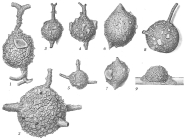RAS taxon details
Astrammina Rhumbler, 1931
413535 (urn:lsid:marinespecies.org:taxname:413535)
accepted
Genus
Astrammina rara Rhumbler, 1931 (type by monotypy)
Pelosphaera Heron-Allen & Earland, 1932 · unaccepted (Subjective junior synonym Opinion...)
Subjective junior synonym Opinion of Loeblich & Tappan, 1987
- Species Astrammina rara Rhumbler, 1931
- Species Astrammina triangularis (Earland, 1933) accepted as Rhabdammina triangularis (Earland, 1933) (Opinion of Zheng & Fu, 2008)
marine, fresh, terrestrial
feminine
Wiesner, H. (1931). Die Foraminiferen der deutschen Südpolar Expedition 1901-1903. <em>Deutsche Südpolar-Expedition, Berlin (Zoology).</em> 20: 53-165.
page(s): p. 77 [details]
page(s): p. 77 [details]
Hayward, B.W.; Le Coze, F.; Vachard, D.; Gross, O. (2025). World Foraminifera Database. Astrammina Rhumbler, 1931. Accessed through: RAS (Eds.) (2025) Register of Antarctic Species at: https://ras.biodiversity.aq/aphia.php?p=taxdetails&id=413535 on 2025-09-13
RAS (Eds.) (2025). Register of Antarctic Species. Astrammina Rhumbler, 1931. Accessed at: https://ras.biodiversity.aq/aphia.php?p=taxdetails&id=413535 on 2025-09-13
Date
action
by
original description
Wiesner, H. (1931). Die Foraminiferen der deutschen Südpolar Expedition 1901-1903. <em>Deutsche Südpolar-Expedition, Berlin (Zoology).</em> 20: 53-165.
page(s): p. 77 [details]
original description (of Pelosphaera Heron-Allen & Earland, 1932) Heron-allen, E.; Earland, A. (1932). Some new Foraminifera from the South Atlantic. IV. Four new genera from South Georgia. <em>Journal of the Royal Microscopial Society.</em> 52: 253-261., available online at https://doi.org/10.1111/j.1365-2818.1932.tb01872.x
page(s): p. 256 [details] Available for editors
page(s): p. 77 [details]
original description (of Pelosphaera Heron-Allen & Earland, 1932) Heron-allen, E.; Earland, A. (1932). Some new Foraminifera from the South Atlantic. IV. Four new genera from South Georgia. <em>Journal of the Royal Microscopial Society.</em> 52: 253-261., available online at https://doi.org/10.1111/j.1365-2818.1932.tb01872.x
page(s): p. 256 [details] Available for editors
 Present
Present  Inaccurate
Inaccurate  Introduced: alien
Introduced: alien  Containing type locality
Containing type locality

